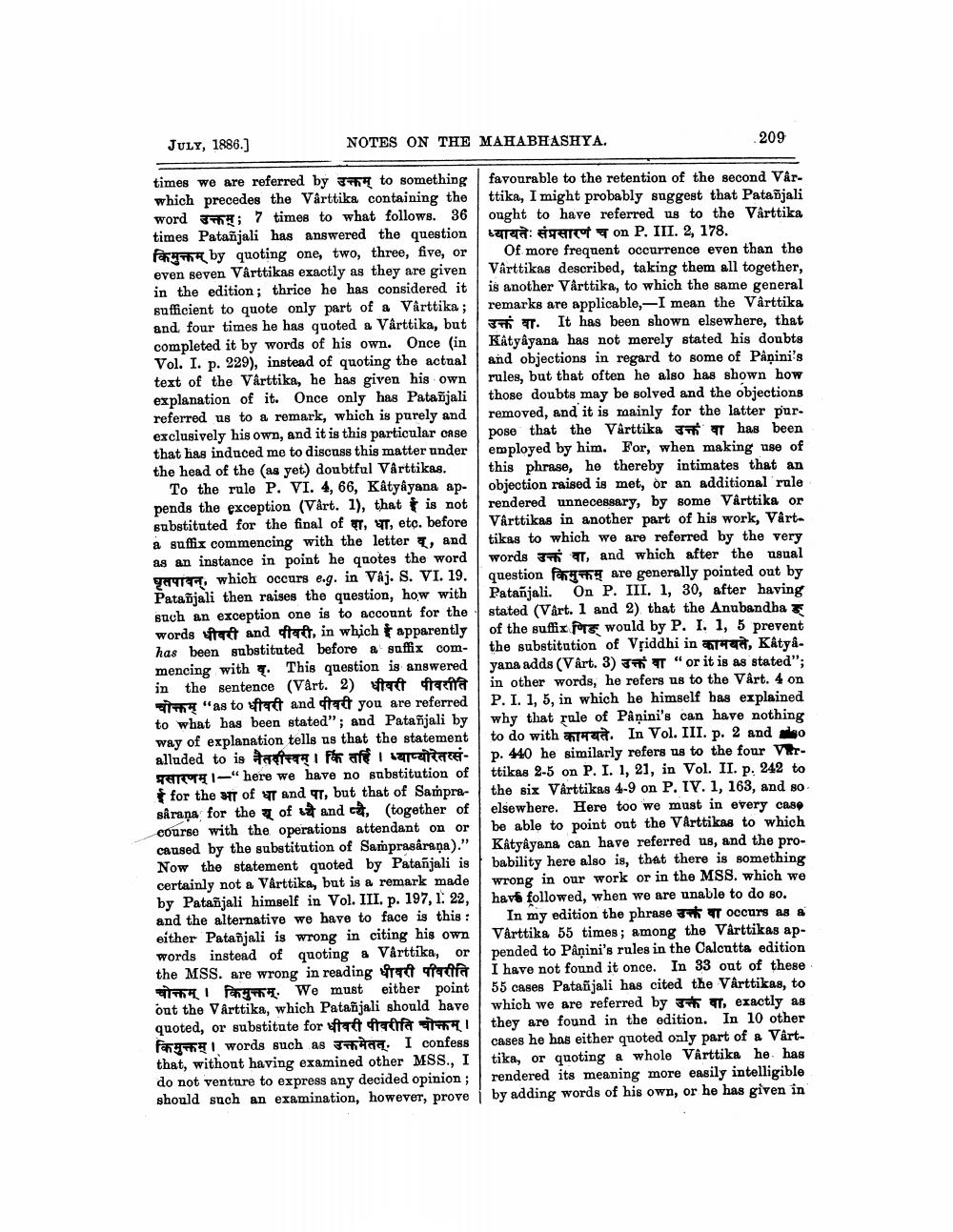________________
JULY, 1886.)
NOTES ON THE MAHABHASHYA.
209
times we are referred by 3 to something favourable to the retention of the second Vår. which precedes the Vårttika containing the ttika, I might probably suggest that Patañjali word ; 7 times to what follows. 36 ought to have referred us to the Vârttika times Patañjali has answered the question tra: arco Ton P. III. 2, 178. fah by quoting one, two, three, five, or Of more frequent occurrence even than the even seven Vârttikas exactly as they are given Värttikas described, taking them all together, in the edition; thrice he has considered it is another Vårttika, to which the same general sufficient to quote only part of a Vârttika; remarks are applicable, -I mean the Vârttika and four times he has quoted a Vârttika, but T. It has been shown elsewhere, that completed it by words of his own. Once (in Katyayana has not merely stated his doubts Vol. I. p. 229), instead of quoting the actual and objections in regard to some of Påņini's text of the Vârttika, he has given his own rules, but that often he also has shown how explanation of it. Once only has Patañjali those doubts may be solved and the objections referred us to a remark, which is purely and removed, and it is mainly for the latter pur. exclusively his own, and it is this particular case pose that the Vårttika
has been that has induced me to discuss this matter under employed by him. For, when making use of the head of the as yet) doubtful Vårttikas. this phrase, he thereby intimates that an
To the rule P. VI. 4, 66, Kátyâyana ap- objection raised is met, or an additional rale pends the exception (Vårt. 1), that is not rendered unnecessary, by some Vârttika or substituted for the final of T, UT, etc. before Vårttikas in another part of his work, Vårt a suffix commencing with the letter , and tikas to which we are referred by the very as an instance in point he quotes the word words , and which after the usual
GTF, which occurs e.g. in Vaj. S. VI. 19. question Pang a re generally pointed out by Patañjali then raises the question, how with Patañjali. On P. III. 1, 30, after having such an exception one is to account for the stated (Vårt. 1 and 2) that the Anubandha words start and start, in which apparently of the suffix fre would by P. I. 1, 5 prevent has been substituted before & suffix com- the substitution of Vriddhi in area, Kâtyä. mencing with . This question is answered yana adds (Vårt. 3) T T "or it is as stated"; in the sentence (Vart. 2) werdt fraefta in other words, he refers us to the Vårt. 4 on
"as to frerit and drait you are referred P. I. 1, 5, in which he himself has explained to what has been stated”; and Patañjali by why that rule of Pâņini's can have nothing way of explanation tells us that the statement to do with a hea. In Vol. III. p. 2 and also alluded to is frete afa
p. 440 he similarly refers us to the four VtrTERTE I-" here we have no substitution of ttikas 2-5 on P. I. 1, 21, in Vol. II. p. 242 to
for the st of NT and , but that of Sampra- the six Vârttikas 4-9 on P. IV. 1, 163, and so skrana for the of ve and ca, (together of elsewhere. Here too we must in every case course with the operations attendant on or be able to point out the Vårttikas to which caused by the substitution of Samprasarana)." Katyayana can have referred us, and the proNow the statement quoted by Patañjali is bability here also is, that there is something certainly not a Vârttika, but is a remark made wrong in our work or in the MSS. which we by Patañjali himself in Vol. III. p. 197, 1. 22, I have followed, when we are unable to do so. and the alternative we have to face is this : In my edition the phrase s T occurs as a either Patañjali is wrong in citing his own Vårttika 55 times; among the Vårttikas apwords instead of quoting a Várttika, or pended to Panini's rules in the Calcutta edition the MSS. are wrong in reading धीवरी पविरीति I have not found it once. In 33 out of these
94 I Pag . We must either point 55 cases Patañjali has cited the Vârttikas, to out the Vårttika, which Patañjali should have which we are referred by the exactly as quoted, or substitute for at frafa
they are found in the edition. In 10 other किमुक्तम् । words such as उक्तमेतत्. I confess cases he has either quoted only part of a Vartthat, without having examined other MSS., I tika, or quoting a whole Vârttika he has do not venture to express any decided opinion; rendered its meaning more easily intelligible should such an examination, however, prove by adding words of his own, or he has given in




